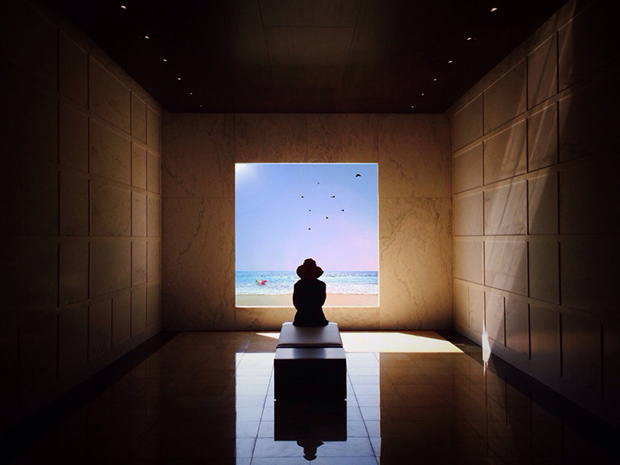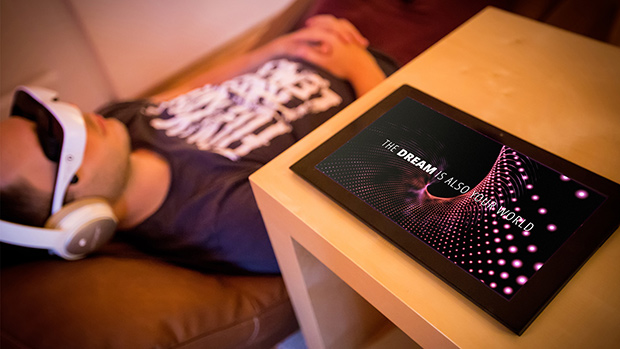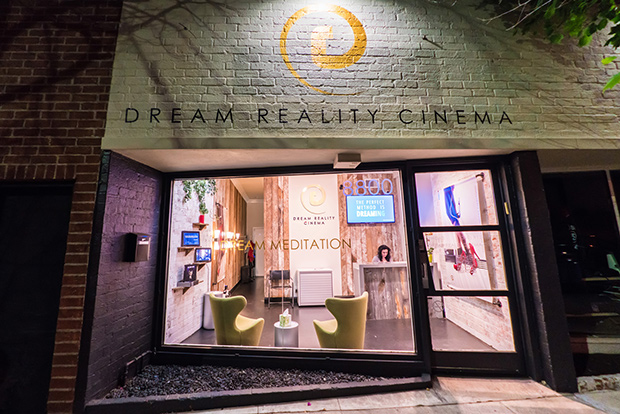
There was a time a few years back when I couldn’t sleep more than four hours a night. I would stay up thinking about work and relationships and looming events. And I’d wake in the middle of the night to the panic of a mish-mash of incomprehensible thoughts — or worse, the jagged whisper of my dad’s last breath. My bed wasn’t a place of restoration — it was a place of unrest. For someone who loves sleep more than hugs, high fives and new kicks, this was source of major distress.
My problem wasn’t uncommon: generalized anxiety disorder. But, like the other 6.8 million Americans with the scarlet “A” stamped across our furrowed foreheads, it was just life. And the plight of restless nights? I was in the company of 50 to 70 million. Thankfully, my sleep habits would slowly improve over time — but I could still count on one terrible, no-good, sub-five-hour sleep at least once a week.
Then, just last month I plopped that normal New York existence into a proverbial blender and pressed “puree.” I was moving to the Wellness-Obsessed Capital of the World: Los Angeles. Despite the immediate assault of sunshine and the purchase of a stupidly expensive new mattress (still worth every penny), I was contending with new work hours, new fears (OMG, driving) and people that seemed so nice (but wait, what’s the catch?). Within two weeks I was Googling day spas, yoga studios and meditation centers like a woman possessed.
RELATED: 8 Signs You’re Way Too Stressed (And How to Deal)
That’s when I came across Dream Reality Cinema in Beverly Hills. Not to be confused with your average popcorn-slinging movie theater, this one plays a single film designed to induce “dream meditation.” Think: eyes wide open, in a floating state of consciousness. Once students master that form of zen, they can move on to lucid dreaming, or the ability to stay conscious while dreaming. (Yup, that means you can control what happens in your dreams, Inception style.) And that’s not all: Some believe you can achieve a higher level of thinking, problem solve more effectively, and tap into a greater world of creativity in such a state.
I made an appointment, and promptly added: “Next-level ish” to my to-do list.

Lucid Dreaming: The Premise
According to the founders, Hungarian philosopher and human cybernetics researcher Sandor Lengyel and physician Emese Toth, MD, the first step to dream meditation requires a bit of guidance. That’s where their 40-minute film comes in, based on 25 years’ worth of studies on dreaming, relaxation and meditative techniques.
As with other forms of meditation, dream meditation taps into your present thoughts, sensations and emotions, but — you guessed it — in a sleepier state (my forte). And while wide-awake meditation practitioners have to deal with physical stimuli around them, dream meditation does two things differently.
“[While dreaming], the brain can freely decide what to do and where to take itself.”
First, it removes those outside influences, allowing people to theoretically reach a meditative state more easily. As Lengyel puts it, “Lucid dreaming is the perfect meditation, because there is no way for your conscious mind to interfere with the practice.” Second, it increases the possibility for growth and change, since certain regions of the brain are more active in a dream-like state. (Namely, parts of the visual cortex, motor cortex and motion-sensory areas deep within the brain, according to some sleep experts.)
Dr. Toth explains: “When we are able to live consciously in our dreams, our colorful, real and memorable dream life can develop and become connected with our wakeful life.” All this brain boosting on top of the traditional meditation benefits, like reduced anxiety, improved sleep and increased productivity, to name a few.
What’s more, there’s a healthy dose of Inception to lucid dreaming: “The film [that’s shown in the studio] provides a precisely engineered brain-regenerating program,” says Dr. Toth. More specifically, it flips a switch on natural processes that have otherwise been turned “off” in our heads, such as the ability to think freely and creatively, she says.
This might be explained by the fact that during sleep-mode, the prefrontal area of the brain becomes less active. This is where logical reasoning resides. “[While dreaming], the brain can freely decide what to do and where to take itself…It can behave naturally and unrestricted because nothing forces it to behave otherwise,” Dr. Toth says. What results: Restoration, serenity, invigoration — or, well, whatever your heart (or head) desires.
RELATED: The Impatient Person’s Guide to Meditation

Dream Reality Cinema: The Experience
On the Uber ride to Dream Reality Cinema, I scrolled through the studio’s testimonials. “Unlike anything I’ve ever experienced before…” “so relaxing…” My driver pulled up to the corner and I hopped out. No fluorescent marquee, but the whitewashed boutique was undeniably 90210-chic.
Inside, I checked in with the receptionist, who escorted me to the two-person cinema room. She invited me to take a seat in a cushy, “zero-gravity” leather chair. (Note to self: BYO meditation date?) It reclined just past 180 degrees, my head a few inches below my feet. My guide requested that my glasses come off. “Sorry, but I’m blind?” “That’s OK,” she said. The super-fancy wraparound specs came on, and she directed my finger to the adjustable focus so even near-sighted folks like me could see.
“Focus, Shakeshaft, you cannot write a story about a fancy nap.”
I asked if I could somehow take notes. She chuckled, assuming I was kidding, and handed me a plush blanket to tuck myself in. (She clearly did not know of my ability to text and Instagram in my sleep.) She asked if I need anything else — water or tea? (Another note to self: BYO Swedish Fish.) I slipped my sandals off as the lights in the room faded to black.
To start the session, newbie lucid dreamers required a primer. A short, animated introduction video offered a few key tips. The first, “Just let yourself react freely.” Meaning: Do not force yourself to meditate, concentrate or, like this writer did, attempt to take mental notes for her article. When text appears on screen, do not zero in to read the words. Instead, maintain ‘full-screen vision.’ “That is, seeing everything at the same time. As you should do in life, as well,” the creators explain. It was 4 p.m. and my brain-slash-life was already foggy from the day. Focus, Shakeshaft, you cannot write a story about a fancy nap.

What followed was a winding path of visualizations to coax me into the elusive conscious-yet-dreaming state. At one point I was prompted to imagine I was a tiny pebble falling into a vast body of water. I played along. Falling, falling and, sure enough, the rest gets fuzzy. My expertly-crafted sensory experience (just as I suspected) had turned into a warm and glorious slumber. How long was I asleep? Would the receptionist know?
I peeled my eyelids apart and settled back into the film, as I was coached to do. Positive affirmations floated to the screen. My thoughts drifted over to my new LA life, my people, my kittens, my self-worth, my ability to conquer whatever lies ahead. Basically, my inner Jessica was telling me “I can do anything good!”
RELATED: 17 Positive Affirmations That’ll Change the Way You Think
I was conscious, that I knew. But was I getting closer to lucid dreaming mode? I waited patiently for my higher-level abilities to kick in. “Mind awake, body asleep. Mind awake, body asleep,” I told myself. Just like Elliot from Mr. Robot chanted during his own reality-bending, hyper-woke episodes. But something (possibly my sudden hunger pangs or late-onset fidgeting) told me I wasn’t quite there.
Moments later, the film concluded and my trusty guide tiptoed back in.
“Mind awake, body asleep. Mind awake, body asleep,” I told myself.
Did I like the experience? I think so.
Did I feel different now than when I walked in? Sorta.
Did I manage to find a dream-like meditative state? Definitely…maybe?
Like a kid who stole the Butterfinger and knew she had to come clean, I told her I maaayy have fallen asleep. Once. OK twice. Lady, I fell asleep three times. But I swear I didn’t mean to!
She reassured me that was totally normal. In fact, most people do on their first visit, she said.
RELATED: True Life: 60 Minutes in a Sensory Deprivation Tank

Living in a Dream: The Assessment
During my hour-long session, no, I did not learn how to lucid dream. And I shouldn’t have expected to. Dr. Toth explains that lucid dreaming takes many sessions of practice and self-analysis. Only with continued practice will “individuals learn to remember, control and eventually unlock valuable information stored deep in the subconscious mind.”
“The dreaming state gives us permission to allow changes within us and we begin to behave and think differently.”
Instead, the dream meditation session teaches you a fundamental skill that you can build upon: “[How] to have an active and independent consciousness instead of being a passive follower of someone or something,” says Dr. Toth. Those guilty of moving robotically from one day to the next? She’s talking to us.
“The dreaming state gives us permission to allow changes within us and we begin to behave and think differently. Sometimes we experience a more evolved way of thinking, a type of expansion,” Dr. Toth says. This is where the so-called boost in creativity, memory function, and other positive changes take place.
RELATED: THIS Is Your Body on Sleep Deprivation
As for the claims that dream meditation will normalize sleep or stress disorders? For me, TBD. While I did sleep like a champ that night, the founders emphasize that any long-term improvements will require a lengthier commitment.
So is this the ultimate brain hack? Or the most fantastical placebo effect this side of the San Andreas Fault? Maybe it doesn’t matter. If you’re taking 60 minutes of your day to clear some headspace, that in and of itself might be the win. At least it was for me.
Dream Reality Cinema has two locations: Los Angeles, CA, and Budapest, Hungary. The studio currently offers one film, Dream Meditation, but is working on a new program, Active Dreaming, which will delve more deeply into lucid dreaming. Each session is $45 and a monthly unlimited membership is $200.
